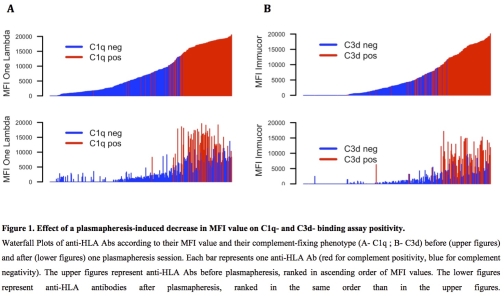Relationship Between Mean Fluorescence Intensity and C1q/C3d-Fixing Capacities of Anti-HLA Antibodies.
G. Claisse,1 L. Absi,2 E. Alamartine,1 N. Maillard,1 C. Mariat.1
1Centre Hospitalier Universitaire - Hôpital Nord, Saint-Etienne, France
2Laboratoire EFS Loire-Auvergne, Saint-Etienne, France.
Meeting: 2016 American Transplant Congress
Abstract number: 192
Keywords: Kidney transplantation, Monitoring, Rejection
Session Information
Session Name: Concurrent Session: Identifying Antibodies - Tools of the Trade
Session Type: Concurrent Session
Date: Monday, June 13, 2016
Session Time: 2:30pm-4:00pm
 Presentation Time: 2:30pm-2:42pm
Presentation Time: 2:30pm-2:42pm
Location: Ballroom B
The capacity of anti-HLA antibodies (Abs) to activate complement is thought to be an informative property susceptible to facilitate outcome prediction. Two different tests, C1q- and C3d-binding assays, have recently been reported as being useful predictors. However, some authors have suggested that complement-binding ability of anti-HLA antibodies and MFI value are tightly correlated, especially when analytical artefacts interfering with MFI determination (prozone effect) are properly corrected. We explore the impact of a decrease of MFI value, realised by plasmapheresis, upon the complement-binding capacity of anti-HLA Abs.
Four hundreds and thirty-three anti-HLA Abs (66% Class I, 34% Class II) were monitored longitudinally (Single Antigen-Bead assay, Luminex) before and after plasmapheresis in their capacity of C1q (One Lambda) and C3d (Immucor) binding according to their respective MFI value. Sera were pre-treated by DTT to control the complement- and IgM-associated prozone effect.
Before plasmapheresis, 33% (145/433) Abs were C1q+. When compared to C1q- Abs, C1q+ Abs had a significantly higher MFI value[17397 (IQR: 14851-18794) vs. 2745 (IQR: 1125-6476), p<0,01]. After one plasmapheresis session, 61% (89/145) of C1q+ Abs turned C1q- with significant lower MFI value as compared to those that remained C1q+ [6268 (IQR: 3906-8063) vs. 14504 (IQR: 10353-16406), p<0,001]. By further decreasing MFI value with prolonged plasmapheresis, all C1q+ Abs became C1q-. MFI value was a strong predictor of C1q positivity with AUC 0,97 (CI 95% 0,95-0,99). Regarding C3d assay, results were comparable with a MFI value higher for C3d+ Abs before and after plasmapheresis (p< 0,01). MFI value was a strong predictor of C3d positivity [AUC 0,96 (CI 95% 0,93-0,98)]. 
Our data suggest that both C1q- and C3d-binding assays are intimately linked to the strength of anti-HLA Abs evaluated by MFI. To what extent complement-binding analysis really improves prediction of graft outcome beyond the sole analysis of unbiased MFI value still remains to be thoroughly evaluated.
CITATION INFORMATION: Claisse G, Absi L, Alamartine E, Maillard N, Mariat C. Relationship Between Mean Fluorescence Intensity and C1q/C3d-Fixing Capacities of Anti-HLA Antibodies. Am J Transplant. 2016;16 (suppl 3).
To cite this abstract in AMA style:
Claisse G, Absi L, Alamartine E, Maillard N, Mariat C. Relationship Between Mean Fluorescence Intensity and C1q/C3d-Fixing Capacities of Anti-HLA Antibodies. [abstract]. Am J Transplant. 2016; 16 (suppl 3). https://atcmeetingabstracts.com/abstract/relationship-between-mean-fluorescence-intensity-and-c1qc3d-fixing-capacities-of-anti-hla-antibodies/. Accessed December 2, 2025.« Back to 2016 American Transplant Congress
